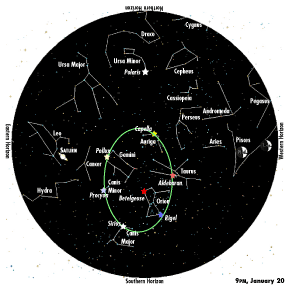 |
Sky Watch
by J. Alex Knoll
|
A Ring of Great Winter Lights
Six bright stars round out the Great Winter Circle 
Thursday’s new moon provides a dark backdrop for stars and constellations. Shining high overhead are some of the brightest and most colorful stars in the heavens, which together form the Great Winter Circle.
Atop the Circle, at 12 o’clock, is bright, yellow Capella of Auriga the Charioteer.
The next star, to the southwest at 5 o’clock, is orange Aldebaran, the eye of Taurus the bull.
Continuing clockwise to near 6 o’clock is the blue giant Rigel, the left leg of Orion the hunter.
East of the circle’s bottom, around 7 o’clock, is brilliant white Sirius the Dog Star of Canis Major, Orion’s great hunting dog. Sirius means dazzling one, which is appropriate as this is the brightest nighttime star.
Next, to the north of 8 o’clock, is Procyon of Canis Minor, Orion’s other hunting dog. Procyon means before the dog, as this star, despite being farther east of Sirius, rises ahead of the Dog Star due to its much higher position.
Completing the circle is Pollux, marking the head of the Gemini twin of the same name. His brother Castor lies nearby but is too dim compared to the other stars of the Winter Circle.
Also not part of the Circle, but rather near dead-center, is one of the most notable stars, Betelgeuse, the the red giant marking Orion’s right shoulder.
Night by night, these stars and their constellations slowly shift westward, disappearing in evening twilight with the arrival of spring.
Immediately following sunset Friday, a sliver of the nascent crescent moon peers above the west-southwest horizon; just a few degrees to the left is Mercury, while Venus is higher.